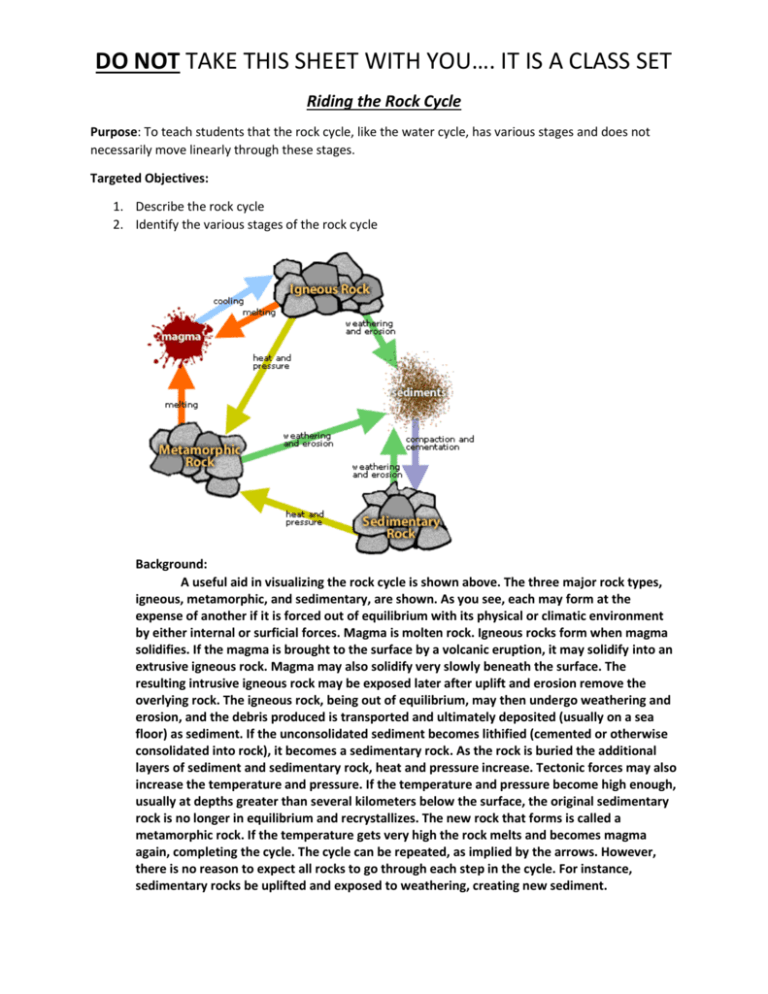directions
advertisement

DO NOT TAKE THIS SHEET WITH YOU…. IT IS A CLASS SET Riding the Rock Cycle Purpose: To teach students that the rock cycle, like the water cycle, has various stages and does not necessarily move linearly through these stages. Targeted Objectives: 1. Describe the rock cycle 2. Identify the various stages of the rock cycle Background: A useful aid in visualizing the rock cycle is shown above. The three major rock types, igneous, metamorphic, and sedimentary, are shown. As you see, each may form at the expense of another if it is forced out of equilibrium with its physical or climatic environment by either internal or surficial forces. Magma is molten rock. Igneous rocks form when magma solidifies. If the magma is brought to the surface by a volcanic eruption, it may solidify into an extrusive igneous rock. Magma may also solidify very slowly beneath the surface. The resulting intrusive igneous rock may be exposed later after uplift and erosion remove the overlying rock. The igneous rock, being out of equilibrium, may then undergo weathering and erosion, and the debris produced is transported and ultimately deposited (usually on a sea floor) as sediment. If the unconsolidated sediment becomes lithified (cemented or otherwise consolidated into rock), it becomes a sedimentary rock. As the rock is buried the additional layers of sediment and sedimentary rock, heat and pressure increase. Tectonic forces may also increase the temperature and pressure. If the temperature and pressure become high enough, usually at depths greater than several kilometers below the surface, the original sedimentary rock is no longer in equilibrium and recrystallizes. The new rock that forms is called a metamorphic rock. If the temperature gets very high the rock melts and becomes magma again, completing the cycle. The cycle can be repeated, as implied by the arrows. However, there is no reason to expect all rocks to go through each step in the cycle. For instance, sedimentary rocks be uplifted and exposed to weathering, creating new sediment. DO NOT TAKE THIS SHEET WITH YOU…. IT IS A CLASS SET Procedure: Part 1 There are seven stations located around the room. You will pick a station to start at (try and limit the number of students at each station to 5). There are dice at each station. You will roll the die to determine what path you will take. It is possible to remain at the same station for a long time, my rule is that you can only stay at one station for 3 turns. Then you must go to another station. While at each station and while moving to the different stations, students must record what is happening on their chart. Location in the Rock Cycle = the name of the station you are visiting Years spent at this station = number of times you rolled the die at this station. Rationale = explain why you were sent to this station (RELATE YOUR REASONING TO WHAT IS OCCURING IN THE ROCK CYCLE AND WHAT WAS DESCRIBED ON THE DIE). Try your best and determine what type of rock is cycling at this particular station (igneous, metamorphic, and sedimentary). Total Age = Do not fill out this section. We will SKIP THIS Part 2 When you are finished: You will create a cartoon strip describing your journey through the rock cycle. Your strip must have at least 12 boxes. Your cartoon strip must have word boxes describing what happened during this part of your journey in the rock cycle, and COLOR. Pages in ISN Chart: pg. 43 Cartoon Strip: pg. 42








